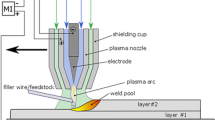The article considers the possibility of using aluminum alloys for manufacturing parts using additive technologies. One of the problems hindering the development of additive technologies is the problem of selecting aluminum alloys with high adaptability to additive manufacturing and high operating properties. Based on the experience gained in the development of granulated aluminum alloys, it is proposed to use aluminum alloys alloyed with transition metals (such as Mn, Cr, Zr, V, Tl, Fe, etc.) in additive manufacturing. These alloys are expected to meet the requirements of additive manufacturing and ensure high mechanical, corrosion and physical properties.The article considers the possibility of using aluminum alloys for manufacturing parts using additive technologies. One of the problems hindering the development of additive technologies is the problem of selecting aluminum alloys with high adaptability to additive manufacturing and high operating properties. Based on the experience gained in the development of granulated aluminum alloys, it is proposed to use aluminum alloys alloyed with transition metals (such as Mn, Cr, Zr, V, Tl, Fe, etc.) in additive manufacturing. These alloys are expected to meet the requirements of additive manufacturing and ensure high mechanical, corrosion and physical properties.


Similar content being viewed by others
References
V. I. Dobatkin, V. I. Elagin, and V. M. Fedorov, Fast Crystallized Aluminum Alloys [in Russian], VILS, Moscow (1995).
I. S. Popkova, V. S. Zolotorevsky, and A. N. Solonin, “Fabrication of products from aluminum and its alloys by the selective laser melting technique,” Tekhnol. Legk. Splavov, No. 4, 14 – 24 (2015).
I. S. Loginova, A. Yu. Churyumov, A. V. Pozdnyakov, and A. N. Solonin, “Microstructural examination of Al – 5% Mg – 0.6% Zr – 0.55% Sc alloy for additive production,” Tekhnol. Legk. Splavov, No. 2, 15 – 24 (2018).
V. I. Elagin, Alloying Deformable Aluminum Alloys with Transition Metals [in Russian], Metallurgiya, Moscow (1975).
B. A. Kopeliovich, “High temperature gas-static treatment — a new technology for improving the quality and properties of parts,” Tekhnol. Legk. Splavov, No. 2, 5 – 9 (1990).
Author information
Authors and Affiliations
Additional information
Translated from Metallovedenie i Termicheskaya Obrabotka Metallov, No. 5, pp. 3 – 8, May, 2021.
Rights and permissions
About this article
Cite this article
Zakharov, V.V. Aluminum Alloys for Additive Technologies. Met Sci Heat Treat 63, 231–235 (2021). https://doi.org/10.1007/s11041-021-00676-8
Published:
Issue Date:
DOI: https://doi.org/10.1007/s11041-021-00676-8




